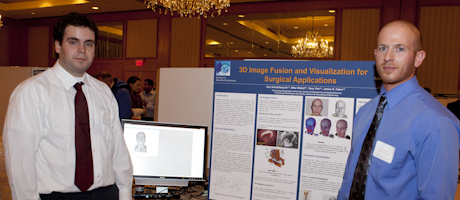By Jennifer Eder
Don’t work from home. Be super frugal until you find your groove. And prepare for a long battle.
Those were some of the tips Eddie Frederick, president and co-founder of LivingSocial – a Washington, D.C. startup – shared with more than 60 GW students at the School of Engineering and Applied Sciences’ annual Student Research and Development Showcase.
“It’s really a great time to be an engineer, and it’s an even better time to start a company,” he said during a keynote address at the Four Seasons Hotel in Georgetown. “It’s a winding road, but it’s been traveled before.”
The aspiring student entrepreneurs listened to Mr. Frederick talk about how his international social buying company, which sends out a deal-of-the-day email to its users, has become the fastest growing company in the industry. Today, LivingSocial has 1,500 employees in six countries, and it just recently raised $175 million from Amazon.com at a valuation of more than $1 billion.
President Steven Knapp called LivingSocial an inspiring example of what the combination of entrepreneurship and engineering can accomplish.
“We hope the students’ achievements will be inspiring to their fellow students as others see their work, and we hope the students will be inspired by the opportunity they have here to interact with successful alumni who themselves are entrepreneurs and leaders in business,” President Knapp said.
Prizes were then awarded to SEAS students based on posters detailing their research. The approximately 60 poster entries were judged by a panel of 15 judges including SEAS professors and alumni. The purpose of the showcase is to highlight student research and development and give students the opportunity to network with successful alumni.
Can Kirmizibayrak and Mike Wakid, both doctoral students in the Department of Computer Science, won the $5,000 first-place prize in the graduate student category. Their winning idea, which aims to improve the success rate and accuracy of surgical procedures, is a 3-D image fusion and visualization software.
“While the amount of medical information available to medical professionals has grown exponentially, the usage of this information is still dependent on physicians’ knowledge and their ability to mentally combine and analyze multiple sources of information,” said Mr. Wakid. “Image-guided surgery aims to help this process by fusing different modalities and visualizing those in a fashion that would give as much information to the physician while removing unnecessary clutter and avoiding information overload.”
Mr. Kirmizibayrak and Mr. Wakid’s software would compile 2-D images, like photographs and videos, and 3-D images, such as CT scans and MRIs.
“This is a phenomenal display of student work,” said SEAS Dean David S. Dolling.
The showcase has grown significantly since its inception in 2007. Graduate and undergraduate student participation has increased as well as the number of judges and sponsors and the amount of prize money.
“Life is about presenting your ideas to a broad public and presenting them in a way that’s understandable to a wide audience,” he said. “We all have to market ourselves so the quicker the students learn how to do that, the more effective they’ll be in whatever job they take.”
The showcase’s second-place prize of $4,000 in the graduate division went to TaiSen Zhuang, a doctoral student in the Department of Mechanical and Aerospace Engineering. He presented a cigarette-sized thruster for propelling small, cube-shaped satellites around space. Mr. Zhuang has applied for two patents for his project, which are both pending.
Chia-Pin Chang, a doctoral student studying electrical and computer engineering, received the third-place prize of $3,000. He presented a compact optical microfluidic uric acid analysis system. The system could help people suffering from gout, a disease caused by the buildup of uric acid in the body, which can result in joint swelling and debilitating pain.
Hannah Stuart, a SEAS senior, won the first-place prize of $2,000 in the undergraduate division. She presented a method for measuring the formation of water droplets inside one type of fuel cell.
Other entries included a mental health software assessment, a microelectromechanical switch to conserve a battery’s life and a steering control collision avoidance system.
“I think all the credit really goes to our students,” said Can Korman, SEAS associate dean for research and graduate studies.


